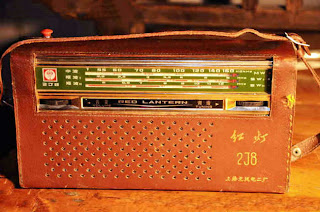Opening the parcel from MIZUHO one finds the following items: α) Frame antenna, β) Control unit, γ) Two connecting cables, δ) Power supply, ε) Documentation.
α) The frame is an almost square printed circuit board, (20x21 cm), with a coil of 6 rectangular rounds on it. It is a PCB antenna.
β) The control unit is a small box which measures 112x90x32 mm. Its front side has got: on/off switch, DX/Local switch, variable capacitor tuning knob. The batteries are cleverly placed on the back side, next to input male RCA (from the loop) and output female ( to the receiver). The interior contains the amplifier and the variable capacitor, a plastic one.
γ) Two interconects are included. One is an RCA to free wires, to be connected to screw input or spring clips connector, the other one is an RCA to a circular wire in order to form a loop around the receiver, achieving an inductive connection.
δ) Power supply has an unusual socket and probably requires a 100V Japanese electricity stantard.
ε) All printed material, leaflets etc is exclusively in Japanese. Drawings are useful.
Performance: I tried the antenna applying varius configurations, with different radio units, sometimes with direct connection if available or making rounds around the radio with the supplied wire.
In all cases the product is worth using as it increases sensitivity and the frame loop provides directionality.
Firstly, I tried UZ-77s with the worst radio in AM, I own, the PANASONIC RF-P50. It was like reviving the dead.This small radio is able to catch only a couple of local transmitters. Even during the night it remains silent in big part of the dial. With the active antenna it behaves like a sensitive, well designed unit.
 |
| SONY ICF-S10MK2 embraced by MIZUHO shined remarkably, receiving more stations than usually, with an improved strength. |
Secondly, I used a very good radio, SONY ICF-EX5MK2. I tried both direct and inductive connections. This already sensitive radio has little to benefit. A certain boost is obvious but not essential for the outcoming result.
 |
| Similar impressions were derived connecting SANGEAN PR-D5. |
Two other radios are Eton G6, and Eton E-100. By the way G6 is a better looking radio with a better user interface than the E-100 but unfortunately has worst performance in audio and is less sensitive into medium waves. I tuned both radios in 1557 KHz, France Info, Nice – Fontbonne, 1515 km away from Athens. Around 21:00 to late night a mediocre with no interference signal is present every day. E-100 received the station with a slight hiss. In G6 the programme was just audible. Mizuho increased the incoming signal to full strength, in both radios.
Finally I tried this active antenna with a classic communications receiver Yaesu FRG-7. This receiver requires only an external antenna. So, here we do not encounter the compromise situation of two different antennas, internal ferrite rod and external, mixed together.
The whole process to tune FRG-7 to a certain frequency is troublesome. One sets the desired MHz, then KHz and finally adjusts band preselector. The outboard MIZUHO needs one more tuning. The result is rewarding. Good signal gain, directionality, no humming noises. Compared with other antennas, MIZUHO is the best medium wave mate for FRG-7. I received, in daytime many stations from Middle East, Italy and the Balkans.
Also, it managed to “catch” many pirates in the frequency segment from 1620 KHz to 1800 KHz. This is the upper limit of operation of this device.
It has been said that FRG-7 is less sensitive at the beginning and at the end of each MHz. This is true for my unit at least. So in the spectrum 850 KHz to 1150 KHz, I turn UZ-77s switch to DX position, covering with success, the receiver’s drawback.
 |
| Reception of a Greek pirate on 1690 KHz. Notice the signal strength meter with active antenna off and then on. |

ΣΥΝΟΨΙΣ
Excluding the case of a communications receiver where a dedicated external antenna is needed, the question that arises is why one uses a relatively expensive unit attached to a cheap radio, and not another, better radio instead.
I think that the answer lies in the domain of the existence of a perfect radio. Probably, as there is no such radio, we try to improve aspects of reception with add-on devices. We combine them in a funny way sometimes, and we therefore create weird configurations. Finally, we end up with a box full of gadgets.
Even though we own various radios, we are aware of the negative sides of each one and we try to overcome the problems employing different methods.
This active antenna corrects weak sensitivity of the receivers tested, since they have got short ferrite rod length as well as design drawbacks and it brings all of them to a similar high level of performance regarding the strength of the incoming signal.
What’s more this PCB antenna is directional, enabling the operator to increase a signal or null another one, with no need to turn the receiver around. Not to mention that Tsuguo Takada, JA1AMH, the man behind Mizuho is a legend of radio waves and using his products is a delight.
 |
| Tsuguo Takada, his photo was found in a Korean web page. |
Ordering an item from Japan can be a bit complicated. The shop "esupporters" in "rakuten" site that sells Mizuho products does not ship outside Japan. But opening an account in “Tenso.com”, one can obtain a shipping address in Japan. So paying an extra charge, they post you the parcel. With some help of “Google translation” and given the reliability of Japanese people, in a week’s time you get your parcel sound and safe.














































